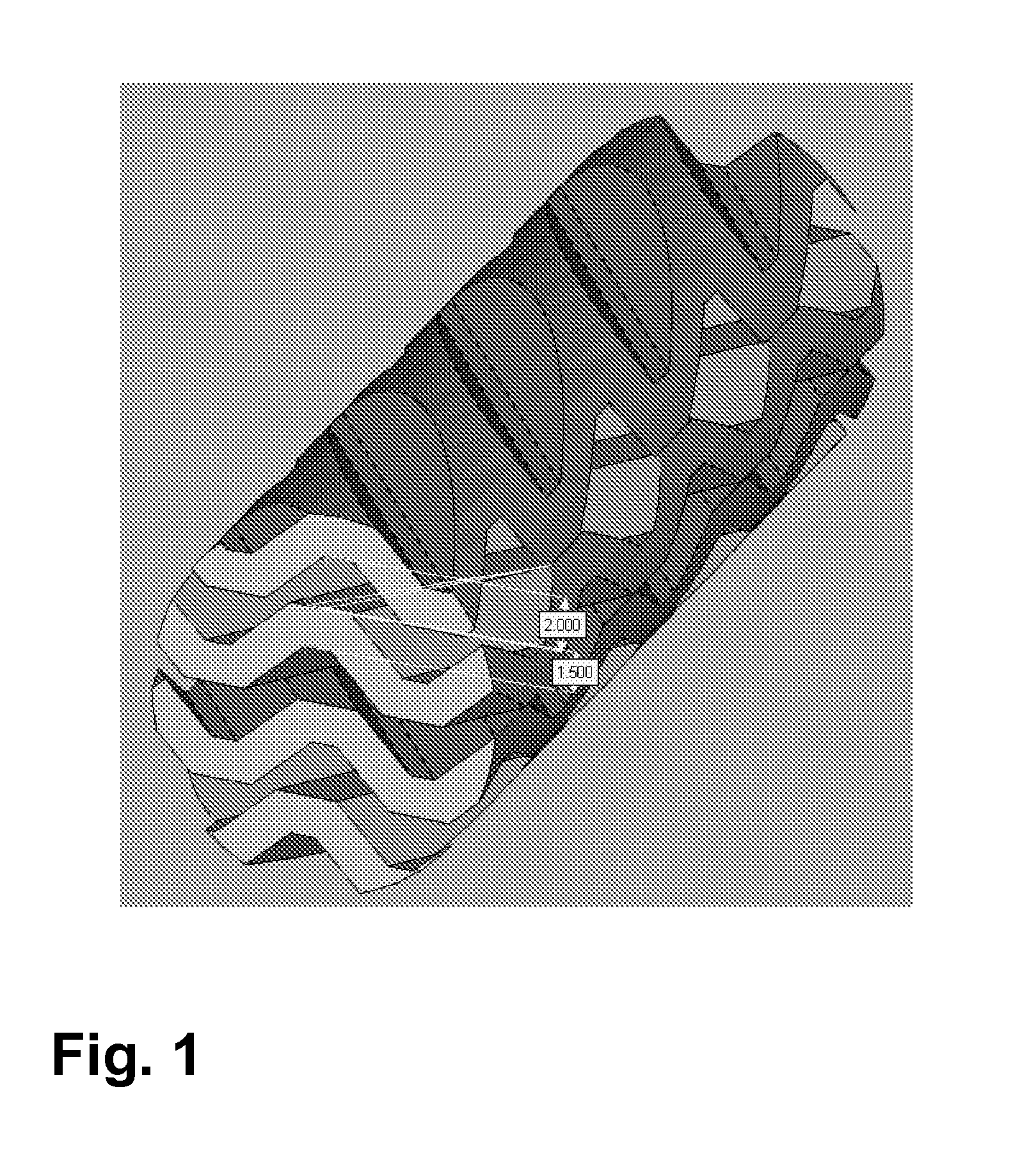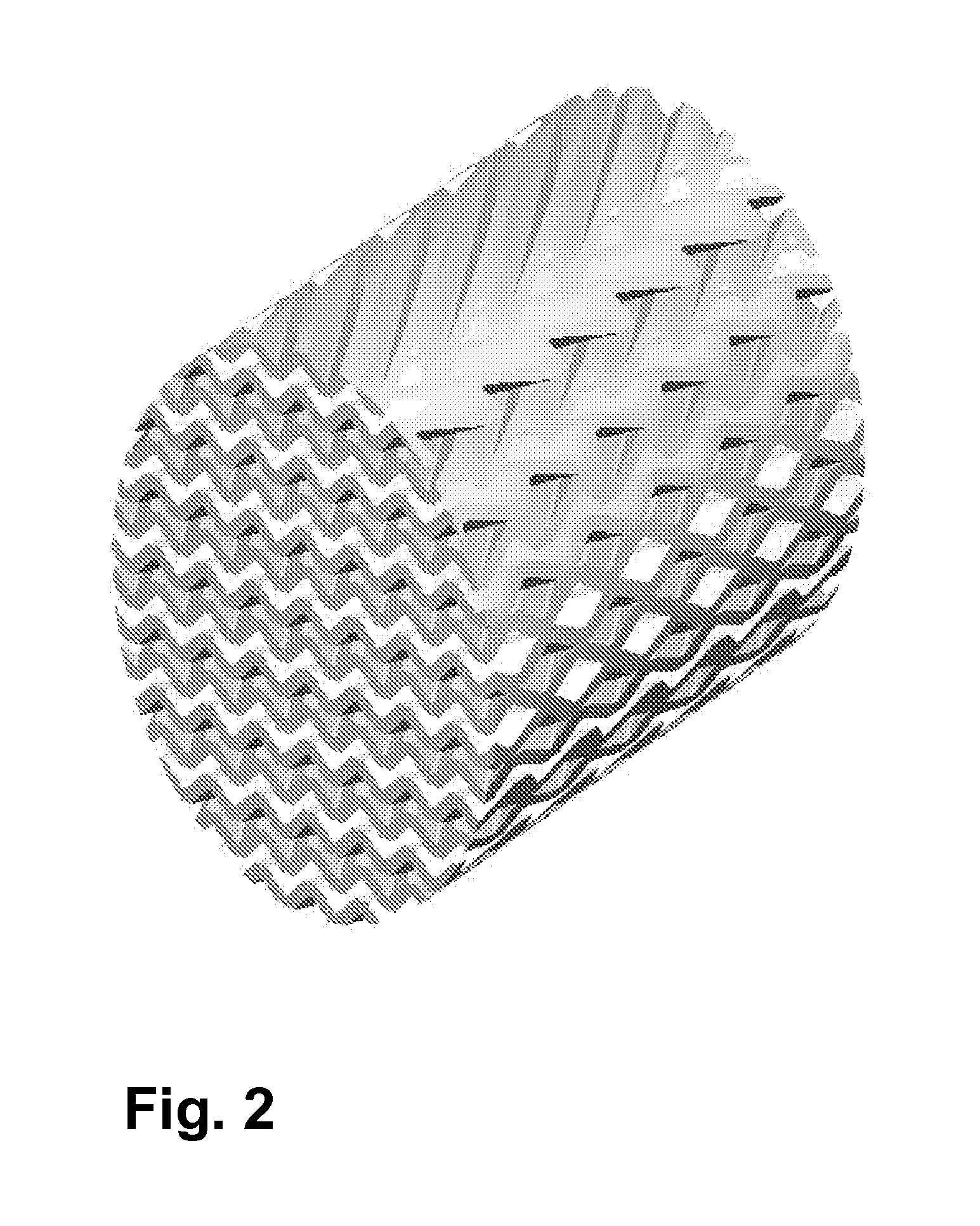Use of shaped bodies having catalytic properties as reactor internals
a technology of catalytic properties and internals, which is applied in the direction of catalyst activation/preparation, metal/metal-oxide/metal-hydroxide catalysts, and additive manufacturing with solids and fluids. it can solve the problems of high pressure drop in the reactor, catalyst is exposed to the reactants only very unevenly, and the removal and installation of the shaped bodies required for the replacement of the catalyst can be very complicated
- Summary
- Abstract
- Description
- Claims
- Application Information
AI Technical Summary
Benefits of technology
Problems solved by technology
Method used
Image
Examples
example 1
[0097]A three-dimensionally structured “cross-channel structure” as shown in FIG. 1 was produced from α-Al2O3. The length is 50 mm and the diameter is 14 mm.
[0098]The basis for the body is granular aluminum oxide CT 3000 SDP (from Almatis, 67065 Ludwigshafen) which is mixed with a solid binder xanthan, 200 mesh (from König & Wiegand, 40472 Düsseldorf) by means of a Turbula mixer (Willy A. Bachofen A G, 4058 Basel, Switzerland). The proportion of solid binder is 10% by weight, based on aluminum oxide. The three-dimensional printing was carried out by means of a Z-Printer 310 (Z-Corporation, Burlington, Mass. 01803, USA) using a water-based binder solution ZB 54 (Z-Corporation, Burlington, Mass. 01803, USA). 2% by weight of the liquid binder was used. After printing, the parts were firstly dried at 60° C. for 8 hours and then blown free by means of compressed air. Ceramic firing was carried out at 1600° C. with a hold time of 2 hours.
example 2
[0099]3.12 g of Bi(NO3)3.5H2O together with 3.36 g of Pd(NO3)2.2H2O and 48.6 mg of Co(NO3)2.6H2O are placed in a glass beaker. 18.17 g of distilled water and 9.08 g of concentrated nitric acid are added and the total mixture is stirred for 1 hour. Seven of the shaped Al2O3 bodies produced by rapid prototyping in example 1 and having a total mass of 42.8 g are placed in a Petri dish and the solution of the metal nitrates is added. The shapes are turned in the solution every 30 minutes and taken from the solution after 3 hours. The shapes are subsequently dried (120° C. for 4 hours) and calcined (heating at 2 K / min to 500° C., held at 500° C. for 10 hours). This gave 7 shapes having a total weight of 44.0 g and comprising 1.4% of Bi, 1.4% of Pd and 0.01% of Co.
example 3
[0101]50 ml of catalyst are installed in a salt bath reactor; a 10 ml layer of steatite is present as inert material at the top and at the bottom. The catalyst is brought to a temperature of 350° C. 120 standard l / h of nitrogen and 35 standard l / h of air are firstly passed over the catalyst, 15 minutes later 32.5 g / h of water are additionally added and a further 15 minutes later 22.4 g / h of cyclohexanone are added. The outputs are collected and the content of the desired reaction product cyclohexenone is determined by gas chromatography. The following table shows the results for the catalysts from example 2 and from comparative example 2 for three different temperatures.
Conversion / mcat / gTemp. / ° C.%Selectivity / %Yield / %Example 23235059.659.435.437065.151.533.539068.443.329.6Comparative4835048.631.715.4example 237048.129.714.339051.025.212.8Conversion = conversion of cyclohexanoneSelectivity = selectivity to cyclohexenoneYield = yield of cyclohexenone
[0102]Despite a lower catalyst mass...
PUM
| Property | Measurement | Unit |
|---|---|---|
| particle size | aaaaa | aaaaa |
| particle size | aaaaa | aaaaa |
| temperatures | aaaaa | aaaaa |
Abstract
Description
Claims
Application Information
 Login to View More
Login to View More - R&D
- Intellectual Property
- Life Sciences
- Materials
- Tech Scout
- Unparalleled Data Quality
- Higher Quality Content
- 60% Fewer Hallucinations
Browse by: Latest US Patents, China's latest patents, Technical Efficacy Thesaurus, Application Domain, Technology Topic, Popular Technical Reports.
© 2025 PatSnap. All rights reserved.Legal|Privacy policy|Modern Slavery Act Transparency Statement|Sitemap|About US| Contact US: help@patsnap.com



